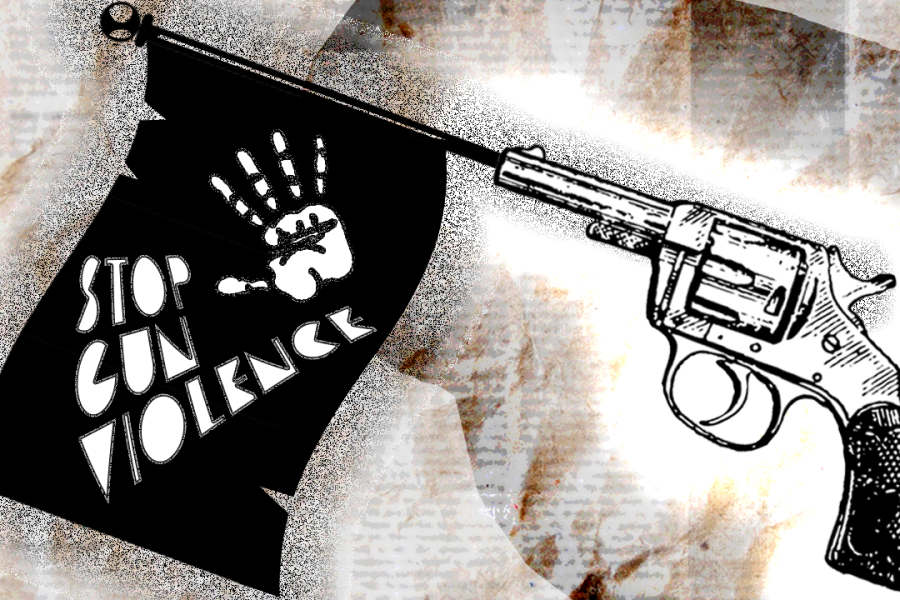Taking aim at gun violence: Tech strategies for reducing harm
Gun violence is now recognized as a pervasive and growing problem in a country with patchwork regulation and 25% more guns than people.

[July 12, 2022: Camille Crittenden, Executive Director, CITRIS and the Banatao Institute]
Gun violence is now recognized as a pervasive and growing problem in a country with patchwork regulation and 25% more guns than people. (CREDIT: Alexa Stegmuller)
The recent spate of mass shootings has galvanized action in Congress and among advocacy organizations large and small. Gun violence is now recognized as a pervasive and growing problem in a country with patchwork regulation and 25% more guns than people. High-profile events like those in Uvalde, Buffalo, Parkland, Charleston, Newtown and the long sad list that could follow belie the fact that mass shootings represent a tragic but vanishingly small percentage of total gun deaths. According to CDC data, more than 45,000 people died by firearm in 2020. Seventy-nine of them were killed in mass shootings.
Such an entrenched, high-stakes and complicated problem will require creative solutions from all corners. As a recent podcast series framed it, approaches to reducing gun violence fall into three categories: education, enforcement and engineering. Many individuals and organizations are dedicated to grappling with the first two. Proposed policy solutions include expanded background checks, improved licensing requirements, raising the minimum age to purchase a gun, instituting a waiting period, limiting the number of guns and ammunition that can be purchased at once, and more. How might engineers, computer scientists and technologists engage more actively in creating solutions? Or curbing the harm enabled by tools we’ve developed for more benign purposes?
3D printers
In addition to printing toys and tools, 3D printers are capable of creating ghost guns and parts. The technology and materials are not yet sufficient to pose a real threat, but the proof-of-concept has alarmed legislators and law enforcement agencies enough to take action.
This polymer handgun — known as a ghost gun — was seized by Berkeley police. It has a 30-round magazine. (CREDIT: Berkeley Police Department)
Although regulations governing such weapons have been mired in judicial and legislative tussles for years, such computer-aided designs (CAD) and instructions for assembling DIY guns and printing ammunition are easily available online.
Related Stories
Striking a balance between the free speech claims of their users and corporate social responsibility goals, social media platforms could limit distribution of this material. For instance, Facebook prohibits advertising for firearms but omits mention of CAD designs for printing such weapons. It should update its terms of service to prohibit such advertising.
A new federal ruling will require that “Privately Made Firearms” must be identified with a serial number or other identifying mark, and California’s AB 2156 would require anyone creating more than three weapons with 3D printers to obtain a license to manufacture firearms. These and similar measures should be promoted, not least by 3D printing companies themselves to avoid reputational harm if their devices are eventually used for violent ends.
Online gun sales
“Commercial firearm posts” by individuals are prohibited on most social media sites, but as a recent Washington Post article revealed, Facebook allows 10 infractions (!) before penalizing gun sellers. Most payment platforms similarly prohibit transactions to buy or sell firearms.
Although this may deter some sales, alternative transaction sites have stepped in: The website GunTab outlines the policies of various online platforms and positions itself as the go-to marketplace. Taken a step further, credit card companies or ACH providers could prohibit sales of certain kinds of weapons using their services, whether online or in-person. Although this may limit the ability to trace such purchases, it could also reduce impulse buys that lead to loss of life.
Social media sites are gradually taking action to remove hate speech and expressions of violent extremism on their platforms. These efforts could be expanded to prevent users who exhibit such behavior from arming themselves through online gun purchases. Effective AI algorithms could identify users with risk protection orders against them (“red flags”) and alert law enforcement if they seek weapons online.
Image recognition
The same technology that learns to distinguish stop signs from party balloons is being applied to detecting weapons. Several companies have commercialized the technology, and it has been deployed in settings like airports, banks, and state fairs.
While safeguards should be established to avoid coupling this application with facial recognition, given the demonstrated flaws and biases inherent in these systems to date, focusing on the presence of weapons seems like a promising approach to alerting law enforcement and accelerating response to threats in high-traffic areas.
Smart guns
Guns that use fingerprint recognition or other biometric data are gradually coming to market for both civilians and law enforcement. From 2015 to 2020, 573 children died from unintentional discharge of firearms, and thousands more died by firearm suicide, often from guns that were not in the hands of their owners; implementing security similar to that which unlocks a cell phone could prevent tragic accidents and limit unauthorized use.
The Armatix iP1 Pistol, a semiautomatic weapon developed by a German company that’s designed to fire only when it’s within a 10-inch range of a paired RFID watch.(CREDIT: Armatix)
This technology could also reduce the effect of gun thefts and the crimes that are frequently committed using stolen weapons.
Electronic record-keeping
Although upgrading its databases and IT systems would improve efficiency in the service of public safety, the Bureau of Alcohol, Tobacco, Firearms and Explosives (ATF) has its hands tied. Contrary to specters raised by gun rights advocates, there is no national registry for gun ownership. Indeed, such a searchable database is prohibited by federal law. (Six states and Washington, DC, have their own registries for certain kinds of weapons.)
The ATF maintains piecemeal documentation, including sales records from gun dealers who have gone out of business. Many of these records are still kept on paper; according to the ATF Office of Enforcement, it “processed” more than 50 million such records in fiscal year 2021: 887,000 electronic and 53.8 million on paper! Even when records are kept digitally and the servers from defunct dealers are turned over to the ATF, such records may not be combined.
The Government Accounting Office forced the ATF to delete 252 million records from servers collected between 2000 and 2016 after determining that collating such information was against federal law. The ATF may scan and digitize the files but may not use character recognition software or other technology that would create searchable data.
Fierce lobbying by the NRA over the years has curbed the Justice Department’s ability to modernize ATF’s systems and expand its budget to meet current operational needs. Gun safety advocates could encourage lawmakers to improve this mundane but essential piece of federal infrastructure.
At the same time, attention could turn to those states that have not yet prohibited creating their own gun registries (eight have such prohibitions, similar to the federal limitations) and urge state officials to establish registries using modern technology.
Clearly technological fixes alone will be ineffective to reduce gun violence without accompanying policies to enable them. A durable means to address loss of life and livelihoods due to guns will require a “whole of society” approach: change in attitudes about gun ownership, stronger regulation from the government and private companies, and the will to enforce it. But technologists and engineers can play a role to use their ingenuity and innovative drive to address this epidemic.
Note: Materials provided above by Camille Crittenden. Content may be edited for style and length.
Like these kind of feel good stories? Get the Brighter Side of News' newsletter.
Joseph Shavit
Head Science News Writer | Communicating Innovation & Discovery
Based in Los Angeles, Joseph Shavit is an accomplished science journalist, head science news writer and co-founder at The Brighter Side of News, where he translates cutting-edge discoveries into compelling stories for a broad audience. With a strong background spanning science, business, product management, media leadership, and entrepreneurship, Joseph brings a unique perspective to science communication. His expertise allows him to uncover the intersection of technological advancements and market potential, shedding light on how groundbreaking research evolves into transformative products and industries.



